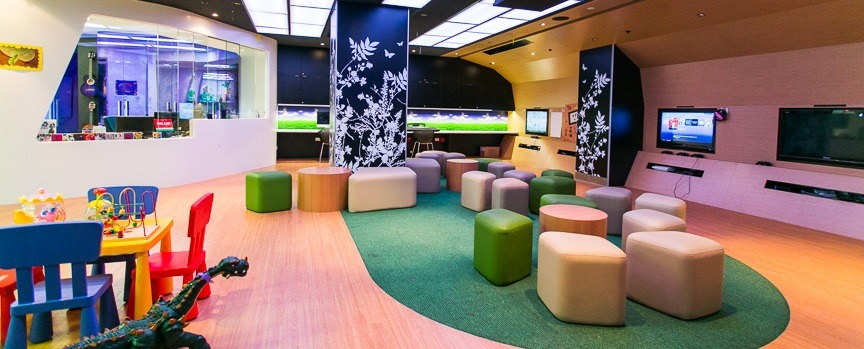Creative Healthcare
Jane Collins, previous CEO of Great Ormond Street Hospital, London was once asked by a major donor ‘Can we afford to have art in hospitals?’ to which she simply replied ‘We can’t afford to have art in hospitals’.
When we design and build a hospital, we are building a community. Every person within a hospital is a member of that community, with a role to play. Communities need spaces where they can eat, rest, and play; where diverse populations can come together, connect and comfort each other. Hospitalization can be isolating, having central places where people gather provides a sense of not being alone, sharing challenging life experiences, belonging to a wider community, and addressing that sense of isolation. These central areas can also provide scope for the outside world to connect with those in the hospital. While the primary function is to deliver medical care, we must also attend to the emotional needs of the hospital community, providing for better mental health and greater well-being. Research tells us that the environment within which we deliver healthcare plays a vital role in health outcomes.
Art and creativity have a vital role to play within the hospital community. Art in health begins with the physical fabric of the building, but this should merely set the stage for further creative programs housed within spaces specifically designed for ongoing activities and events.
Physical artworks should engage us visually and can also be interactive so that we can engage mentally and physically with them. Art and design should be fundamental to way-finding strategies, with features integrated into theming and layering, helping us navigate unfamiliar surroundings while creating a sense of place, not just a hospital.

The art collection carefully curated by Lynne Seaar at The Lady Cilento Children’s Hospital in Brisbane is a stunning example of art enriching and personalizing the surroundings.
The best contemporary creative healthcare architecture demonstrates a clear understanding of hospital communities’ needs beyond the delivery of medical care and recognizes the need to accommodate and encourage creativity. Great hospitals no longer provide just medical facilities. Examples include spaces designed for public performance, exhibition spaces, art studios, activity centers, cinemas, even TV studios where patients can create content to be shared on bedside entertainment systems.
In children’s facilities, art and design should spark the imagination and encourage creativity and play. Keeping imagination active and vibrant is vital to their recovery. Children and young people have to be able to imagine getting better, imagine getting out of the hospital, and imagine getting back home to everyday life. Play is essential to children and young people’s cognitive, physical, social, and emotional development – teaching how to share, negotiate, resolve conflicts, and learn about themselves and others. For children and young people, play is their way of exploring and processing their experiences and surroundings and so is vitally important in a hospital setting. However, play is also very important for entire families, providing a way to connect and engage with one another in a unique, creative, and imaginative way. In designing children’s hospitals, we must provide highly visible, easily accessible spaces which facilitate all types of play and allow children and families to come together, play together – maintaining strong child-parent bonds under stressful circumstances.
A recent design brief for the new children’s hospital in Copenhagen is an exceptional example that demonstrates a clear understanding of the vital nature of play in children’s healthcare, with ‘Integrated play’ listed as one of five design principles:
“Integrated play.
Children do not stop playing simply because they fall ill. Play must therefore be an integrated part of design, life and experience. This entails not only providing play areas and playtime, but ensuring that play is fully integrated into the entire treatment process. Play can help the child accept illness and treatment, for example, if the child is allowed to treat another person or a toy animal. Play must be a common thread running through the entire stay in hospital.
We intend to take play seriously. The Academy will conduct research into – and provide training in – the link between play and recovery – with staff, families and patients.”
Another brilliant example of bespoke spaces designed to encourage play and creativity are the Starlight Express Rooms, provided to Australian children’s hospitals by Starlight Children’s Foundation. These rooms are creativity hubs that literally buzzing with excitement and fun. These spaces are designed and fully kitted out, to accommodate all manner of creative activities from arts and crafts, singing, dancing, film recording, production, screenings, gaming, etc. They are the highlight of many children and young people’s experiences of hospitalization. This is an organization that truly, deeply understands the transformative power of creativity and imagination.

Creativity should also go beyond the building and extend into outdoor spaces. Numerous studies have shown that access to the outdoors, fresh air, and sunlight are hugely important. Inspiring outdoor spaces also encourage play, creativity, and physical exercise. Strong examples of inspirational outdoor spaces can be seen at The Lady Cilento Children’s Hospital in Brisbane, Centenary Hospital for Women & Children, Canberra, and the Peter MacCallum Cancer Centre in Melbourne.

The integration of arts into both the physical environment and the creative healthcare experience has been shown to have wide-ranging positive impacts which include – reduced stress experienced by patients, families, and staff; reduced drug requirements; decreased recovery times; shortened hospital stays; improvements in clinical outcomes; enhanced quality of service provision; improvements in staff job satisfaction and well-being and generally improved healthcare experiences for everyone. With so many benefits to be gained the return on investment is high.
Jane Collins, previous CEO of Great Ormond Street Hospital, London was once asked by a major donor ‘Can we afford to have art in hospitals?’ to which she simply replied ‘We can’t afford to have art in hospitals’.
By Victoria Jones
